Bring On that Sweet Immersive Audio
Editor's Note: This guide was last updated on 5/17/2017.
This has definitely been the year for in-your-face audio. Sorry, did that go over your head? Well so does the sound of immersive audio: literally - over your head! Immersive audio systems deliver sound not just all around you, but above you as well, and they're becoming more pervasive and more affordable.
In 2014, we got a little taste of Dolby Atmos as it rolled out to select receivers and preamp/processors. And though the movie selection on Blu-ray was slim, there were a few titles released in 2014. In 2015, we've seen more Dolby Atmos-enabled products than ever before. Even better, we've gotten a lot of really good Dolby Atmos-encoded content: films like "Gravity," "American Sniper" and "Mad Max: Fury Road" all came out with Dolby Atmos soundtracks on Blu-ray Disc.
This year, we've also seen the official launch of another major player in immersive audio: DTS:X. Like Dolby Atmos, DTS:X uses object-oriented encoding to create a truly three-dimensional soundfield. That way, you can really experience those sky-high explosions, planes flying overhead, rainstorms, buildings collapsing and more.
To indulge in Dolby Atmos or DTS:X, you will need a receiver that supports at least one of these formats, as well as new speakers and encoded content. Currently, there are several Dolby Atmos Blu-rays available, with "Ex Machina" being the lone DTS:X-capable Blu-ray. ("American Ultra" was also recently announced.)
You have to cut DTS a little slack; they're still new. First announced back in April, DTS:X support doesn't come out of the box -- yet. However, there are several receiver models that will be eligible for that DTS:X upgrade, reportedly by the end of 2015. A third immersive audio format, AURO-3D, is also available on select higher end gear.
Before you buy a receiver, think about how many speakers you want to have. At bare minimum, you're going to need five surround speakers, a subwoofer, and two height channels. This is what's known as a 5.1.2 configuration. However, bigger rooms can accommodate additional speakers, so you may want to think into adding four height speakers to make a 5.1.4 or even a 7.1.4 setup. Whatever you decide, make sure your new receiver can support your configuration. Want to know who is selling what? Let's take a deep dive on what Dolby Atmos and DTS:X-capable receivers are out now.
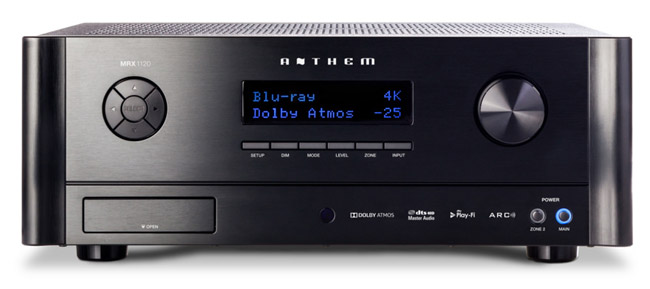
Anthem
Anthem currently has two Atmos-enabled receivers, the MRX 720 and the MRX 1120. Both models come with Dolby Atmos and DTS:X support out of the box.
It should be noted that both models feature DTS Play-Fi, which means you can make either receiver part of a larger whole-house wireless music system. Besides being able to stream a variety of music files and services, both models are compatible with any and all DTS Play-Fi speakers and other components -- even if they aren't made by Anthem.
The MRX 720 is an 11.2-channel pre-amp with seven amplifier channels that can crank 140 watts per channel. This model also has eight HDMI 2.0a inputs with HDCP 2.2, 4K pass-through, and High Dynamic Range (HDR) support. Other features include 32-bit/768 kHz differential-output DACs, ARC (Anthem Room Correction), quad-core digital signal processing, two sub-out jacks, RS-232 control options, and more. The MRX 1120 has all of the same features as the MRX 720, but bumps the amplifier section up to a full 11 channels.
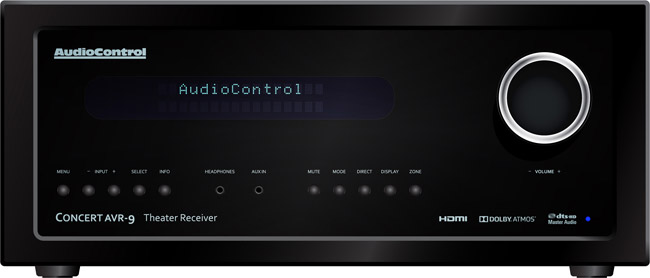
AudioControl
AudioControl still has the Concert AVR-7 and Concert AVR-9, which feature 4K support via seven HDMI 2.0a inputs and two HDMI outputs. Each one also has HDCP 2.2 support, four coax SPDIF and two Toslink digital audio inputs, six stereo analog inputs, a USB port, and an Ethernet jack. The AVR-9 boasts 7 x 200 watts per channel, with the AVR-7 offering 100 watts per channel. Both also include Dirac Live room correction and integration with Crestron, Control 4, Savant, and RTI systems.
According to AudioControl, both models support 7.1.4 Atmos configurations (for configurations above eight total channels, additional power amplification is required), and can be upgraded to DTS:X once the firmware is available.
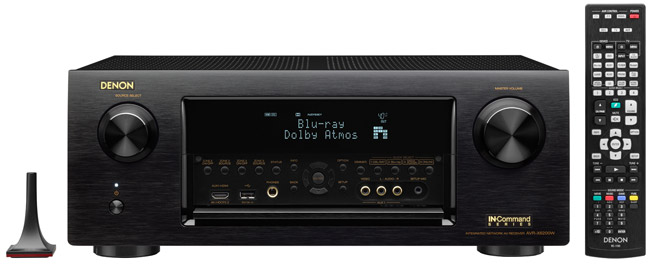
Denon
First announced in June 2016, the 7.2-channel AVR-X3300W boasts 105 watts per channel and 4K/60Hz full-rate pass-through, as well as 4:4:4 color resolution, HDR, and BT.2020 support. It also has Dolby Atmos capabilities (up to 5.1.2) out of the box, with a free DTS:X upgrade available now. Other features include a 4K upscaler, Dolby Surround and DTS Neural: X upmixers (via update), eight HDMI 2.0a/HDCP 2.2 inputs, two HDMI outputs, and ISFccc calibration. It even has Bluetooth and Wi-Fi built in, high-resolution audio support, and options for multiroom use.
In late summer 2016, Denon debuted the AVR-X4300H and AVR-X6300H as its first HEOS receivers. This means that both models can be integrated into a wireless setup, streaming music to HEOS speakers throughout the house. The AVR-X4300H is a 9.2-channel AVR, with 125 watts (8 ohms, 0.05%THD, 20Hz~20kHz) per channel. It features Dolby Atmos and DTS:X, with Auro-3D available via an optional, paid upgrade. Out of the box, the 4300 can deliver a 7.1.2 or 5.1.4 immersive sound experience or you can add an external two-channel amp to get a 7.1.4 setup. Other features include Wi-Fi, Bluetooth, AirPlay, and eight HDMI 2.0a inputs with HDCP 2.2, and three HDMI outputs.
The AVR-X6300H bumps that up to 11 channels of amplification, rated for up to 140 watts each. So you can do a full-out 7.1.4 channel immersive surround sound system right out of the box. It also has a discrete monolithic amplifier design with custom-made DHCT (Denon High Current Transistors), gold-plated input/output terminals, transparent speaker terminals, and the Audyssey MultEQ XT32 automatic room acoustic measurement and correction system.
In May 2017, Denon released the AVR-S930H and the AVR-S730H, a pair of receivers that can do Dolby Atmos and DTS:X (up to 5.1.2 channels) for under $600. Both are also part of the HEOS lineup for wireless music streaming throughout the house.
Both of these 7.2-channel receivers also have support for 4K Ultra HD content with Dolby Vision and HDR10 High Dynamic Range (HDR) passthrough, HDCP 2.2, BT.2020, Wide Color Gamut, and 4:4:4 Pure Color sub-sampling. HLG (Hybrid Log Gamma) HDR support will be added to each component via a future firmware update.
The AVR-S930H boasts 185 watts per channel, seven HDMI inputs and two HDMI outputs around the back, as well as another HDMI input on the front. The AVR-S730H promises 165 wpc, with six HDMI inputs and one output on the back and one HDMI input on the front. Either receiver supports up to a 5.1.2 channel configuration (two height channels). Or if you decide not to go immersive just yet, you can do a traditional 5.1 or 7.1 channel set-up instead.
Other features on both include Bluetooth, dual-band Wi-Fi, and AirPlay, as well as support for High Resolution Audio in the form of DSD (2.8/5.6MHz), FLAC, ALAC, and WAV files.
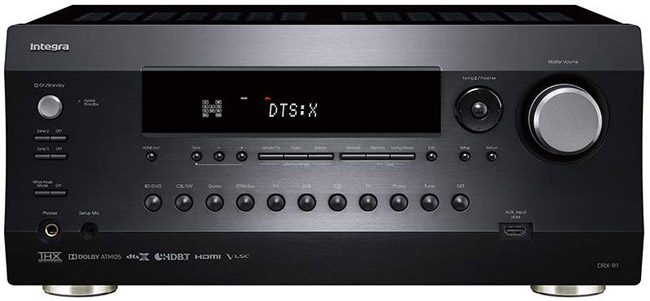
Integra
Integra currently has five receivers that support both Dolby Atmos and DTS:X. The DRX-2, DRX-3, and DRX-4 can deliver that sound to 5.1.2 configurations. The DRX-2 boasts 80 watts per channel, with the DRX-3 bumping that number up to 100 and the DRX-4 delivering 110. All three support 4K with HDR, HDCP 2.2, and playback of high-resolution audio. The DRX-2 has six HDMI inputs and one output, with the other two packing eight HDMI inputs and two HDMI outputs.
Also worth noting is that the DRX-4 is THX certified and all three models will be eligible for future firmware to add Google Cast and MQA (Master Quality Authenticated) support.
In late 2016, the company started selling the DRX-7, a THX Select2Plus-certified AVR can deliver 5.2.4 sound or 7.2.4-channel sound with an add-on stereo amplifier. Promising 140 watts per channel, this model also features Vector Linear Shaping Circuitry (VLSC), options for multiple zones of music, and HDBaseT support. Other features include hi-res audio playback, eight HDMI inputs and two HDMI outputs with HDCP 2.2, Chromecast, and more.
At the same time, the company introduced the DRX-R1. This is also a THX Select2Plus-certified receiver, but with the ability to do 7.2.4 channels. Aside from hi-res support, this model also has THX Loudness Plus technology, HDBaseT, eight HDMI inputs and two HDMI outputs with HDCP 2.2 compatibility, and multizone playback options. Designed specifically for custom installation, this model has RS232 and IP control with support for 2-way communication with third party home automation systems.
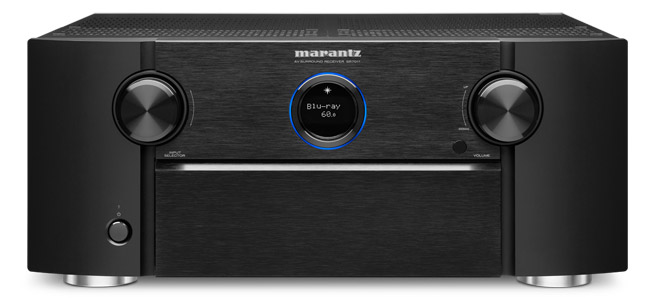
Marantz
Released in 2016, the NR1607 is a super-slim 7.2-channel AVR that can deliver 50 watts per channel at 8ohms (20-20kHz, 0.08%THD). It even has eight HDMI 2.0a inputs with full HDCP 2.2 compatibility, as well as 4K 60Hz video, 4:4:4 Pure Color sub-sampling, High Dynamic Range (HDR), Wide Color Gamut compatibility, 21:9 video, 3D, and BT.2020 pass-through on every input. Other features include high-resolution audio support, Bluetooth, Wi-Fi, AirPlay, and Audyssey MultEQ room calibration. This model will support a 5.1.2 Atmos configuration out of the box, but DTS:X firmware is available now.
In July 2016, Marantz introduced the SR5011, a 7.2-channel receiver that promises 100 watts per channel (8ohm, 20Hz - 20kHz, THD: 0.08%), with support for Dolby Atmos (up to 5.1.2) and DTS:X (via a firmware upgrade). Other features include Marantz's own HDAMs (Hyper Dynamic Amplifier Module) and plenty of networking options, as well as 4K Ultra HD 60Hz video support, 4:4:4 Pure Color sub-sampling, High Dynamic Range (HDR) and 21:9 video, 3D, and BT.2020 pass-through on every input. It also has the latest HDMI 2.0a and HDCP 2.2 specifications on all eight of the unit's HDMI inputs.
Other features on both include Wi-Fi and Bluetooth, hi-res audio playback, and AirPlay.
In May 2017, Marantz released its latest Slimline receiver, the NR1608. Standing just 4.1 inches tall, this 7.2-channel AVR delivers Dolby Atmos and DTS:X out of the box for a 5.1.2-channel configuration. Some of the image perks include 4K-60Hz video to HDR and Dolby Vision, with Hybrid Log Gamma coming via a future firmware update. It even promises analogue-to-HDMI conversion and SD/HD-to-4K upscaling to boost the quality of legacy content and components. Other features include 7x50W (8 ohms, 20 Hz~20 kHz, 0.08% THD) amplification, eight HDMI inputs, ISF certification, and Wi-Fi.
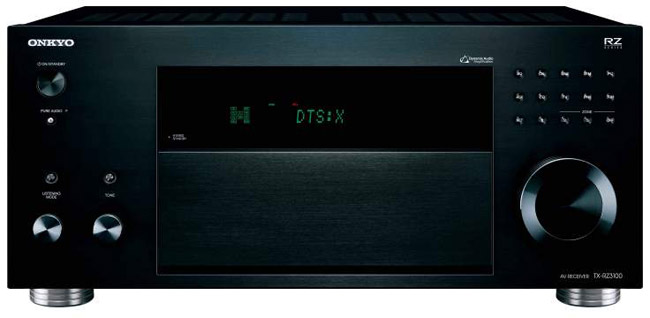
Onkyo
The 9.2-channel TX-NR1030 and the 11.2-channel TX-NR3030 are still selling. Each of these has THX Select2 Plus certification, two 32-bit DSP engines, seven discrete TI Burr-Brown DACs, a dedicated HDMI Zone 2 Out for routing video to a second display, WiFi, Bluetooth, and even a phono input. Both also have eight HDMI inputs and three HDMI outputs, with support for 4K video at 60Hz with HDCP 2.2 for 4K streaming and broadcasts. Other features include DTS Neo:X, AccuEQ room calibration, a 4K/60 Hz HDMI Sub Out, and Marvell's Qdeo technology. The TX-NR3030 also includes plenty of options for high-res audio, via 192 kHz/32-bit processors and 192 kHz/24-bit two-channel DACs.
For Dolby Atmos configurations, the TX-NR1030 supports 5.1.2, 5.1.4, and 7.1.2 configurations using the on-board amps. It can be bumped up to 7.1.4 or 9.1.2 by adding a separate stereo amp. The TX-NR3030 can handle any Atmos configuration up to 7.1.4 or 9.1.2 using its on-board amps.
The TX-NR545 ($599) is a 7.2-chanel AVR that can support Dolby Atmos with 5.1.2. channels, and has the Dolby surround up-mixer to give non-Atmos content a boost. Offering 65 watts per channel (8 Ohms, 20 Hz-20 kHZ, 0.7% 2 Ch, FTC), this model also has WiFi, AirPlay, and Bluetooth, as well as HDMI and HDCP 2.2 support that can pass 4K/60Hz video with the 4:4:4 color space and a 21:9 cinema aspect ratio. Other features include a 384kHz/32-bit hi-grade AKM DAC, the AccuEQ perk, six HDMI inputs, and a USB port.
The TX-NR646 is a 7.2-channel AV receiver with support for Dolby Atmos out the box. DTS:X is available via firmware. For both audio formats, these receivers can support up to a 5.1.2. setup.
The TX-NR646 promises 170 watts per channel, with two 32-bit DSP engines, a 384kHz/32-bit AK4458 DAC from Asahi-Kasei, eight 4K/60Hz-ready HDMI 2.0a inputs and two outputs, as well as dedicated HDCP 2.2-compliant terminals for 4K streaming and Ultra HD Blu-ray with Dolby Atmos or DTS:X audio. It can also support HDR color and the 21:9 cinema-aspect ratio.
Other features include WiFi, AirPlay, Bluetooth, and DLNA, which can deliver 192/24 FLAC and DSD 5.6MHz high-res audio files.
The TX-NR555 is the least expensive in this lineup, promising 80 watts per channel (8 Ohms 20-20kHz, 2 Channels Driven, FTC), six HDMI inputs, a USB port, and a phono input. The TX-NR656 bumps the power up to 100 wpc, with the TX-NR757 rocking out 110 wpc. Both have Onkyo's H.C.P.S. (High Current Power Supply) and Dynamic Audio Amplification, as well as eight HDMI inputs (with one in the front) and two HDMI inputs. The TX-NR757 also adds in a 12v trigger and THX certification.
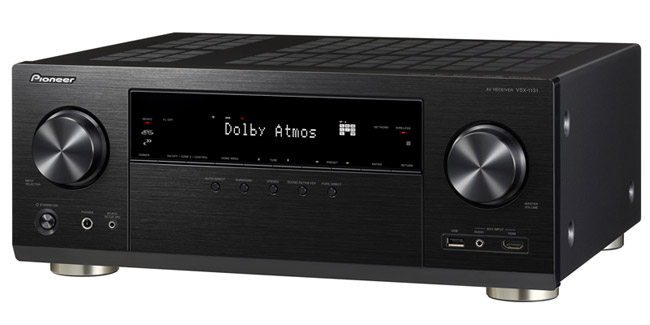
Pioneer
Pioneer is still selling the VSX-1131, a 7.2-channel receiver that can crank 100 watts per channel (20Hz-20kHz,.08%THD@8ohm 2ch Driven) and supports Dolby Atmos in a 5.2.2 or 5.1.2 configuration.
The VSX-1131 also adds in DTS:X support via a firmware update, as well as TIDAL and Google via an upgrade. Out of the box, it has a 384 kHz/32-bit DAC, Pandora, the Multi-Channel Acoustic Calibration System (MCACC), dual-band Wi-Fi, and Bluetooth. Also expect Hi-Res Audio support and 4K/60p/4:4:4 24-bit video with HDCP 2.2 via seven HDMI inputs (with one of those on the front) and two outputs.
The SC-87 and the SC-89 are also all still available. These 9.2-channel Elite AVRs received Dolby Atmos via a free firmware upgrade. Each one can support Dolby Atmos configurations of 5.1.2, 5.1.4, and 7.1.2 channels. They also have Class D3 amplifier technology, MCACC Pro calibration, ESS SABRE32 Ultra DACs, HDMI 2.0, multizone network capabilities, and Roku Ready certification. Boasting 140 watts per channel, the SC-87 has more robust multi-zone capabilities, with the SC-89 offering upgraded digital and analog audio circuitry.
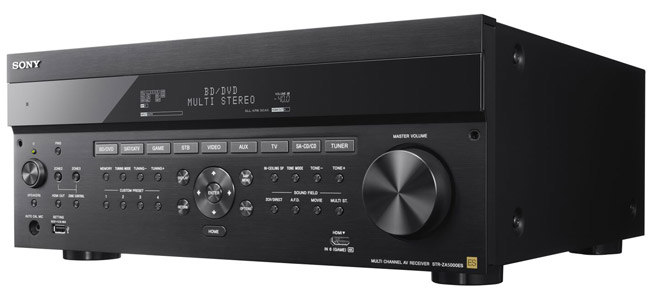
Sony
In early 2016, Sony started shipping the STR-ZA5000ES. Promising 130 watts for each of its nine channels, this model can support a Dolby Atmos and/or DTS:X audio configuration of up to 7.1.2. If you want to pump that up to a 7.1.4 setup, you can add in an external stereo power amp. Something else worth mentioning is that this model has Sony's latest D.C.A.C. EX technology, with a Speaker Relocation feature. This is designed for less-than-ideal listening environments by closely simulating the soundfield produced by optimally positioned and angled speakers. Other features include six HDMI inputs with support for 3D, 4K and HDR, as well as two HDMI outputs (all with HDMI version 2.0, HDCP 2.2). It also has two component video inputs, composite video, andlog and digital audio inputs, support for high-res audio, and an integrated 8-port Ethernet hub.
In March 2017, Sony announced the STR-DN1080 HiFi AV Receiver. This affordable 7.2-channel receiver features Dolby Atmos, DTS:X, and Sony's "Phantom Surround Back" technology, which allows listeners to enjoy 7.1.2-channel surround effects from a 5.1.2-channel configuration. Other audio perks include High-Resolution Audio and D.C.A.C. EX. On the video side, it has six HDMI inputs and two outputs with full HDCP 2.2 support for the latest 4K 60P 4:4:4 Ultra HD content, the new BT.2020 wide color gamut broadcast standard for HDR content, Bluetooth, AirPlay, and wireless multiroom capabilities.
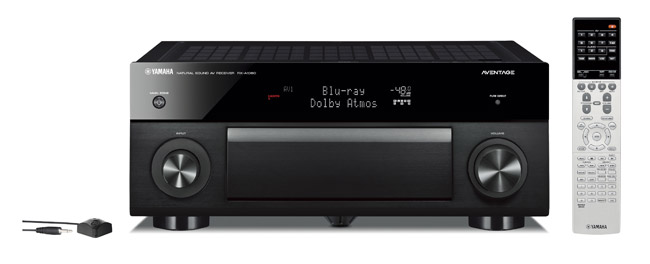
Yamaha
In May 2016, Yamaha debuted six new receivers under the Aventage RX-A 60 Series. All six include Dolby Atmos, DTS:X, support for 4K Ultra HD and HDR pass-through, and MusicCast wireless audio features. Each model can also play high-resolution audio files (ALAC at 96kHz / 24-bit, WAV, AIFF, FLAC up to 192kHz / 24-bit, DSD to 5.6MHz).
The flagship Aventage RX-A3060 is an 11.2-channel receiver, which can deliver Dolby Atmos and DTS:X setups with 5.1.4 channels, 7.1.2 channels, or 7.1.4 channels (with an external 2-channel amplifier). Boasting 150 watts per channel, this model also has an ESS SABRE 32-bit DAC, a phono input, and YPAO R.S.C. with 3D, multipoint, an 11.2-channel precision equalizer and 64-bit resolution. The RX-A2060 is a slight step down, dropping the option to add in the extra amp. The 9.2-channel AVR also has 140 watts per channel, two ESS SABRE DACs, a phono input, and the YPAO R.S.C. with 3D, multipoint, and angle measurement.
The Aventage RX-A1060 and RX-A860 are two 7.2-channel receivers that can each do Dolby Atmos and DTS:X setups of 5.1.2 channels or you can opt for 5.1 channels with Zone 2 features and auto switching. The A1060 boasts 110 watts per channel, with the A860 dropping that down to 100 watts. Both have eight HDMI inputs, with the A1060 putting HDCP 2.2 on seven of those and the A860 with HDCP 2.2 on two. Both have two HDMI/HDCP 2.2 outputs, the YPAO R.S.C. with multipoint measurement, and a phono input.
The last two 2016 models are the RX-A760 and the RX-A660. These 7.2-channel receivers can do Dolby Atmos and DTS:X in 5.1.2 channels. The A760 can also output 5.1 channels plus Zone 2 with auto switching. Promising up to 90 watts per channel, the A760 has six HDMI inputs (three with HDCP 2.2), a phono input, a subwoofer parametric EQ down to 15.6Hz, and YPAO with Reflected Sound Control (R.S.C.). The A660 can do 80 watts per channel, with four HDMI inputs and the Extra Bass feature.
That wraps things up for the current crop of immersive audio receivers. We'll be sure to update this guide as new models are announced.
Related Articles: